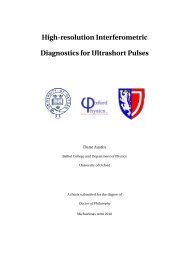Transport of heat and electricity in metals and semiconductors
Transport of heat and electricity in metals and semiconductors
Transport of heat and electricity in metals and semiconductors
You also want an ePaper? Increase the reach of your titles
YUMPU automatically turns print PDFs into web optimized ePapers that Google loves.
96HANDOUT 10. TRANSPORT OF HEAT AND ELECTRICITY IN METALS AND SEMICONDUCTORSTemperature Scatter<strong>in</strong>g κ W-F ratio(scatterer) times σVery low τ κ ≈ τ σ κ ∝ T , L 0(impurities) ∼ const σ ∼ constT ∼ θ D /10 τ κ ∝ T −3 , κ ∝ T −2 , < L 0(phonons) τ σ ∝ T −5 → e −θF/T σ ∝ T −5 → e −θF/TT >∼ θ D τ κ ≈ τ σ κ =const, L 0(phonons) ∝ T −1 σ ∝ T −1Table 10.1: Summary <strong>of</strong> the temperature dependences <strong>of</strong> scatter<strong>in</strong>g times <strong>and</strong> electrical <strong>and</strong> thermalconductivities.10.1.10 SummaryA summary <strong>of</strong> the temperature dependences <strong>of</strong> scatter<strong>in</strong>g times <strong>and</strong> electrical <strong>and</strong> thermal conductivitiesis given <strong>in</strong> Table 1. Typical electrical resistivity <strong>and</strong> thermal conductivity data are shown <strong>in</strong> Figures 10.4<strong>and</strong> 10.5. Note that for reasonably pure <strong>metals</strong> with reasonably simple b<strong>and</strong>structures (e.g. alkali <strong>and</strong>noble <strong>metals</strong>), electrical resistivity data are all <strong>of</strong> a similar form, <strong>and</strong> when normalised to the valueat T = θ R lie roughly on the same curve when plotted aga<strong>in</strong>st T/θ R (see Figure 10.4); here θ R is acharacteristic temperature similar (but not identical) to θ D .10.1.11 Electron–electron scatter<strong>in</strong>gIn <strong>metals</strong> with simple Fermi surfaces, electron–electron scatter<strong>in</strong>g is relatively unimportant. Initial <strong>and</strong>f<strong>in</strong>al states for both electrons must have energies close to E F <strong>and</strong> wavevectors close <strong>in</strong> magnitude tok F ; <strong>in</strong> addition, energy <strong>and</strong> momentum must be conserved. The comb<strong>in</strong>ation <strong>of</strong> these two requirementsmakes electron-electron scatter<strong>in</strong>g quite unlikely (<strong>and</strong> actually completely forbidden at T = 0).However, electron-electron scatter<strong>in</strong>g becomes more important when• the Fermi surface is complicated, so that there the conservation <strong>of</strong> energy <strong>and</strong> momentum becomeseasy for a wider variety <strong>of</strong> possible scatter<strong>in</strong>g processes <strong>and</strong>/or• the density <strong>of</strong> states at the Fermi energy is very large (because the effective mass is large), bump<strong>in</strong>gup the number <strong>of</strong> <strong>in</strong>itial <strong>and</strong> f<strong>in</strong>al states (e.g. transition <strong>metals</strong>, heavy fermion compounds).Reasonably simple arguments 4 show that electron-electron scatter<strong>in</strong>g leads to τ −1 ∝ T 2 .Some typical data for transition <strong>metals</strong> are shown <strong>in</strong> Figure 10.6. At low temperatures, the resistivitiestend towards the T 2 dependence expected for electron-electron scatter<strong>in</strong>g.10.2 Electrical conductivity <strong>of</strong> <strong>semiconductors</strong>10.2.1 Temperature dependence <strong>of</strong> the carrier densitiesOver wide ranges <strong>of</strong> temperature, the dom<strong>in</strong>ant contribution to the temperature dependence <strong>of</strong> the electricalconductivity is the rapidly vary<strong>in</strong>g number <strong>of</strong> free carriers. Recall<strong>in</strong>g the results <strong>of</strong> Section 6.3.4,<strong>in</strong> order to f<strong>in</strong>d n <strong>and</strong> p when impurities are present we use the law <strong>of</strong> Mass Action (Equation 6.12)np = T 3 W e − Egk B Tcomb<strong>in</strong>ed with the conservation law (Equation 6.17)n − p = N D − N A ,where N D is the density <strong>of</strong> donors <strong>and</strong> N A is the density <strong>of</strong> acceptors (both are assumed to only provideone carrier each).347.4 See e.g. Solid State Physics, by N.W Ashcr<strong>of</strong>t <strong>and</strong> N.D. Merm<strong>in</strong> (Holt, R<strong>in</strong>ehart <strong>and</strong> W<strong>in</strong>ston, New York 1976) page









![Extended Notes 8 [pdf]](https://img.yumpu.com/50123548/1/190x245/extended-notes-8-pdf.jpg?quality=85)




![Handout 3 [pdf] - University of Oxford Department of Physics](https://img.yumpu.com/46475432/1/190x245/handout-3-pdf-university-of-oxford-department-of-physics.jpg?quality=85)